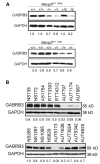Epigenetic overlap in autism-spectrum neurodevelopmental disorders: MECP2 deficiency causes reduced expression of UBE3A and GABRB3
- PMID: 15615769
- PMCID: PMC1224722
- DOI: 10.1093/hmg/ddi045
Epigenetic overlap in autism-spectrum neurodevelopmental disorders: MECP2 deficiency causes reduced expression of UBE3A and GABRB3
Abstract
Autism is a common neurodevelopmental disorder of complex genetic etiology. Rett syndrome, an X-linked dominant disorder caused by MECP2 mutations, and Angelman syndrome, an imprinted disorder caused by maternal 15q11-q13 or UBE3A deficiency, have phenotypic and genetic overlap with autism. MECP2 encodes methyl-CpG-binding protein 2 that acts as a transcriptional repressor for methylated gene constructs but is surprisingly not required for maintaining imprinted gene expression. Here, we test the hypothesis that MECP2 deficiency may affect the level of expression of UBE3A and neighboring autism candidate gene GABRB3 without necessarily affecting imprinted expression. Multiple quantitative methods were used including automated quantitation of immunofluorescence and in situ hybridization by laser scanning cytometry on tissue microarrays, immunoblot and TaqMan PCR. The results demonstrated significant defects in UBE3A/E6AP expression in two different Mecp2 deficient mouse strains and human Rett, Angelman and autism brains compared with controls. Although no difference was observed in the allelic expression of several imprinted transcripts in Mecp2-null brain, Ube3a sense expression was significantly reduced, consistent with the decrease in protein. A non-imprinted gene from 15q11-q13, GABRB3, encoding the beta3 subunit of the GABAA receptor, also showed significantly reduced expression in multiple Rett, Angelman and autism brain samples, and Mecp2 deficient mice by quantitative immunoblot. These results suggest an overlapping pathway of gene dysregulation within 15q11-q13 in Rett, Angelman and autism and implicate MeCP2 in the regulation of UBE3A and GABRB3 expressions in the postnatal mammalian brain.
Figures




Similar articles
-
MeCP2 deficiency in Rett syndrome causes epigenetic aberrations at the PWS/AS imprinting center that affects UBE3A expression.Hum Mol Genet. 2005 Apr 15;14(8):1049-58. doi: 10.1093/hmg/ddi097. Epub 2005 Mar 9. Hum Mol Genet. 2005. PMID: 15757975
-
Homologous pairing of 15q11-13 imprinted domains in brain is developmentally regulated but deficient in Rett and autism samples.Hum Mol Genet. 2005 Mar 15;14(6):785-97. doi: 10.1093/hmg/ddi073. Epub 2005 Feb 2. Hum Mol Genet. 2005. PMID: 15689352
-
15q11-13 GABAA receptor genes are normally biallelically expressed in brain yet are subject to epigenetic dysregulation in autism-spectrum disorders.Hum Mol Genet. 2007 Mar 15;16(6):691-703. doi: 10.1093/hmg/ddm014. Epub 2007 Mar 5. Hum Mol Genet. 2007. PMID: 17339270 Free PMC article.
-
The role of MeCP2 in brain development and neurodevelopmental disorders.Curr Psychiatry Rep. 2010 Apr;12(2):127-34. doi: 10.1007/s11920-010-0097-7. Curr Psychiatry Rep. 2010. PMID: 20425298 Free PMC article. Review.
-
Evolving role of MeCP2 in Rett syndrome and autism.Epigenomics. 2009 Oct;1(1):119-30. doi: 10.2217/epi.09.13. Epigenomics. 2009. PMID: 20473347 Free PMC article. Review.
Cited by
-
Dysregulation of the long non-coding RNA transcriptome in a Rett syndrome mouse model.RNA Biol. 2013 Jul;10(7):1197-203. doi: 10.4161/rna.24286. Epub 2013 Apr 17. RNA Biol. 2013. PMID: 23611944 Free PMC article.
-
Increased copy number for methylated maternal 15q duplications leads to changes in gene and protein expression in human cortical samples.Mol Autism. 2011 Dec 12;2(1):19. doi: 10.1186/2040-2392-2-19. Mol Autism. 2011. PMID: 22152151 Free PMC article.
-
A common susceptibility factor of both autism and epilepsy: functional deficiency of GABA A receptors.J Autism Dev Disord. 2013 Jan;43(1):68-79. doi: 10.1007/s10803-012-1543-7. J Autism Dev Disord. 2013. PMID: 22555366 Review.
-
Power calculations for likelihood ratio tests for offspring genotype risks, maternal effects, and parent-of-origin (POO) effects in the presence of missing parental genotypes when unaffected siblings are available.Genet Epidemiol. 2007 Jan;31(1):18-30. doi: 10.1002/gepi.20189. Genet Epidemiol. 2007. PMID: 17096358 Free PMC article.
-
Somatosensory and sensorimotor consequences associated with the heterozygous disruption of the autism candidate gene, Gabrb3.Behav Brain Res. 2011 Jan 1;216(1):36-45. doi: 10.1016/j.bbr.2010.06.032. Epub 2010 Aug 10. Behav Brain Res. 2011. PMID: 20699105 Free PMC article.
References
-
- Volkmar FR, Pauls D. Autism. Lancet. 2003;362:1133–1141. - PubMed
-
- Amir RE, Van den Veyver IB, Wan M, Tran CQ, Francke U, Zoghbi HY. Rett syndrome is caused by mutations in X-linked MECP2, encoding methyl- CpG-binding protein 2. Nat Genet. 1999;23:185–188. - PubMed
-
- Lalande M. Parental imprinting and human disease. Annu Rev Genet. 1996;30:173–195. - PubMed
-
- Zoghbi HY. Postnatal neurodevelopmental disorders: meeting at the synapse? Science. 2003;302:826–830. - PubMed
-
- Mount RH, Charman T, Hastings RP, Reilly S, Cass H. Features of autism in Rett syndrome and severe mental retardation. J Autism Dev Disord. 2003;33:435–442. - PubMed
Publication types
MeSH terms
Substances
Associated data
- Actions
- Actions
Grants and funding
LinkOut - more resources
Full Text Sources
Other Literature Sources
Medical
Miscellaneous

